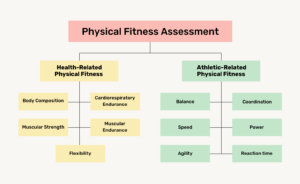Skeletal muscle fibres can be categorised into two distinct types, each serving a specific purpose in human movement and having unique energy requirements. These types are known as slow-twitch muscle fibres and fast-twitch muscle fibres. The predominance of either muscle fibre type depends on the nature and intensity of the physical activity. Let’s delve into a brief overview of each type.
Table of Contents
Slow-twitch Muscle fibres
Before we explore the nature of slow-twitch muscle fibres, let’s briefly examine mitochondria, myoglobin, and oxygen-metabolising enzymes.
- Mitochondria, often referred to as the cell’s powerhouse, play a pivotal role in energy production within the cell.
- Myoglobin, a protein found in muscles, is responsible for supplying oxygen to muscle cells.
- Oxygen-metabolising enzymes, specialised molecules within our cells, facilitate chemical reactions involving oxygen.
Slow-twitch muscle fibres possess numerous mitochondria, a high concentration of myoglobin, and other oxygen-metabolising enzymes. This type of muscle fibre derives energy from aerobic metabolism. Aerobic metabolism is the process by which our cells utilise oxygen to convert nutrients into energy, water, and carbon dioxide.
Referred to as oxidative fibres, slow-twitch muscle fibres contract at a relatively slow rate and can sustain contractions for extended periods without becoming fatigued. In simpler terms, they exhibit high resistance to fatigue due to their efficient utilisation of oxygen and their ability to generate energy through aerobic metabolism.
Slow-twitch muscle fibres are particularly well-suited for endurance and low-intensity activities of prolonged duration, such as long-distance running or cycling.
Fast-twitch Muscle fibres
In contrast, fast-twitch fibres contract quickly and with greater force than slow-twitch fibres. They are specifically recruited for high-intensity activities requiring strength and power. Fast-twitch muscle fibres are further divided into type IIa fibres and type IIx fibres.
Type IIa muscle fibres
Type IIa fibres experience relatively rapid fatigue yet possess a moderate mitochondrial density, enabling efficient contraction and recovery during most intermittent sports activities. They source their energy from anaerobic metabolism (energy produced in the absence of oxygen). Type IIa muscle fibres are well suited for prolonged bouts of anaerobic exertion, making them particularly suitable for activities like sprinting or weightlifting.
Type llx muscle fibres
Type IIx muscle fibres, often referred to as super fibres within the body, have remarkable power and strength when activated. These fibres exhibit a considerably lower capillary density, resulting in a white appearance unlike the pinkish hue of type IIa fibres. Additionally, they have a lower mitochondrial density, contributing to their high fatigue rate.
Due to their fast-twitch nature, type IIx fibres can generate rapid and powerful contractions but are less efficient at sustaining prolonged activity compared to type IIa fibres. Type IIx muscle fibres are predominantly used during explosive movements that require maximum force output, such as jumping or throwing.
| Sportspeople dominant in type I muscle fibres | Sportspeople dominant in type Il muscle fibres |
|---|---|
| Cross-country runners | Weightlifters |
| Triathletes | Gymnasts |
| Distance swimmers | Baseball players |
| Cyclists | Paddle sport players |
| Nordic skiers | Sprinters |
| And so on | And so on |
In summary, individuals involved in endurance sports, such as long-distance running or cycling, usually possess a greater number of type I muscle fibres. These fibres are tailored for prolonged activities, effectively utilising oxygen to produce energy through aerobic metabolism. Conversely, those engaged in power-based and intermittent sports, like weightlifting or sprinting, typically possess a higher number of type II muscle fibres. This category includes type IIa and type IIx fibres, which rely on anaerobic metabolism for energy production, facilitating short bursts of high-intensity efforts but demonstrating a tendency to fatigue more rapidly.




